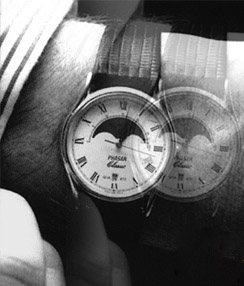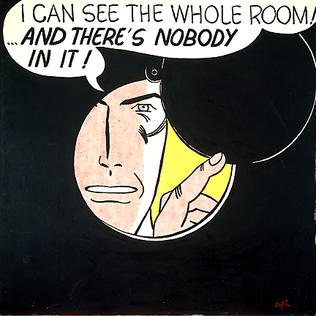A monocular is a modified refracting telescope.
| Look up monocular in Wiktionary, the free dictionary. |
Monocular may also refer to:
- Monocular vision, vision in which each eye is used separately.
- Monocular O, a variant of Cyrillic letter O
A monocular is a modified refracting telescope.
| Look up monocular in Wiktionary, the free dictionary. |
Monocular may also refer to:
| This disambiguation page lists articles associated with the title Monocular. If an internal link led you here, you may wish to change the link to point directly to the intended article. |

In biology, binocular vision is a type of vision in which an animal having two eyes is able to perceive a single three-dimensional image of its surroundings. Neurological researcher Manfred Fahle has stated six specific advantages of having two eyes rather than just one:

A monocular is a modified refracting telescope used to magnify the images of distant objects by passing light through a series of lenses and usually prisms, the application of prisms resulting in a lightweight, compact telescope. Volume and weight are less than half those of binoculars of similar optical properties, making a monocular easy to carry, and also proportionally less expensive. Monoculars produce 2-dimensional images, while binoculars add perception of depth, assuming one has normal binocular vision.

Depth perception is the visual ability to perceive the world in three dimensions (3D) and the distance of an object. Depth sensation is the corresponding term for animals, since although it is known that animals can sense the distance of an object, it is not known whether they "perceive" it in the same subjective way that humans do.

Amaurosis fugax is a painless temporary loss of vision in one or both eyes.

O is a letter of the Cyrillic script.
The visual field is the "spatial array of visual sensations available to observation in introspectionist psychological experiments".

Diplopia is the simultaneous perception of two images of a single object that may be displaced horizontally, vertically, diagonally, or rotationally in relation to each other. It is usually the result of impaired function of the extraocular muscles, where both eyes are still functional, but they cannot turn to target the desired object. Problems with these muscles may be due to mechanical problems, disorders of the neuromuscular junction, disorders of the cranial nerves that innervate the muscles, and occasionally disorders involving the supranuclear oculomotor pathways or ingestion of toxins.

Monocular rivalry is a phenomenon of human visual perception that occurs when two different images are optically superimposed. During prolonged viewing, one image becomes clearer than the other for a few moments, then the other image becomes clearer than the first for a few moments. These alternations in clarity continue at random for as long as one looks. Occasionally one image will become exclusively visible and the other image invisible.
Monocular vision is vision in which both eyes are used separately. By using the eyes in this way, as same to binocular vision, the field of view is increased, while depth perception is limited. The eyes of an horse with monocular vision are usually positioned on opposite sides of the animal's head, giving it the ability to see two objects at once. The word monocular comes from the Greek root, mono for single, and the Latin root, oculus for eye.

The optokinetic response is a combination of a slow-phase and fast-phase eye movements. It is seen when an individual tracks a moving object with their eyes, which then moves out of the field of vision at which point their eye moves back to the position it was in when it first saw the object. The reflex develops at about 6 months of age.

The AN/PVS-14 Monocular Night Vision Device (MNVD) is in widespread use by the United States Armed Forces as well as NATO allies around the world. It uses a third generation image intensifier tube, and is primarily manufactured by Litton Industries and ITT Corporation It is often used 'hands free' using a head harness or attached to a combat helmet such as the PASGT, Advanced Combat Helmet, or Marine Lightweight Helmet. It can also be used as a weapons night sight. In addition, it was part of the equipment fielded in the U.S. Army's Land Warrior program. Nord Atlantic USA is the Military and Law Enforcement distributor of the Harris/Elbit AN/PVS-14 Gen 3 Autogated. Morovision Night Vision was the Law Enforcement distributor of the NEPVS-14 for ITT Exelis.

Multiocular O is a rare glyph variant of the Cyrillic letter O. This glyph variant can be found in certain manuscripts in the Old Church Slavonic phrase "серафими многоꙮчитїи". It was documented by Yefim Karsky from a copy of Psalms from around 1429, now found in the collection of the Trinity Lavra of St. Sergius. It was proposed for inclusion into Unicode in 2007 and incorporated as character U+A66E in Unicode version 5.1 (2008).

Monocular O is one of the exotic glyph variants of Cyrillic letter O. This glyph variant was used in certain manuscripts in the root word ꙩко (eye), and also in some other functions, for example, in the word- and syllable-initial position. It is used in some late birchbark letters of the 14th and 15th centuries, where it is usually differentiated from a regular о, used after consonants, also by width, being a broad On (ѻ) with a dot inside.

Binocular O is one of the exotic glyph variants of Cyrillic letter O. This glyph variant can be found in certain manuscripts in the plural or dual forms of the root word eye, like Ꙫчи.

Double monocular O is one of the exotic glyph variants of Cyrillic letter O. This glyph variant can be found in certain manuscripts in the plural or dual forms of the word eye, for example ꙭчи "[two] eyes".
Monocular deprivation is an experimental technique used by neuroscientists to study central nervous system plasticity. Generally, one of an animal's eyes is sutured shut during a period of high cortical plasticity. This manipulation serves as an animal model for amblyopia, a permanent deficit in visual sensation not due to abnormalities in the eye.

Torpedo...Los! is a 1963 pop art oil on canvas painting by Roy Lichtenstein. When it was last sold in 1989, The New York Times described the work as "a comic-strip image of sea warfare". It formerly held the record for the highest auction price for a Lichtenstein work. Its 1989 sale helped finance the construction of the current home of the Museum of Contemporary Art, Chicago in 1991.

I Can See the Whole Room...and There's Nobody in It! is a 1961 painting by Roy Lichtenstein. It is a painting of a man looking through a peephole. It formerly held the record for highest auction price for a Lichtenstein painting.

The chameleon is among the most highly visually-oriented lizards, using this sense in prey capture, mating behavior, and predator avoidance. Unique features of chameleon vision include a negative lens, a positive cornea, and monocular focusing. The development of the chameleon visual system could have evolved to aid in prey capture and/or in predator avoidance.

Crak! is a 1963 pop art lithograph by Roy Lichtenstein in his comic book style of using Ben-Day dots and a text balloon. It was used in marketing materials for one of Lichtenstein's early shows. It is one of several of his works related to military art and monocular vision.